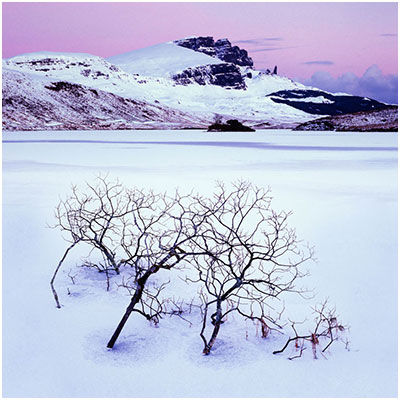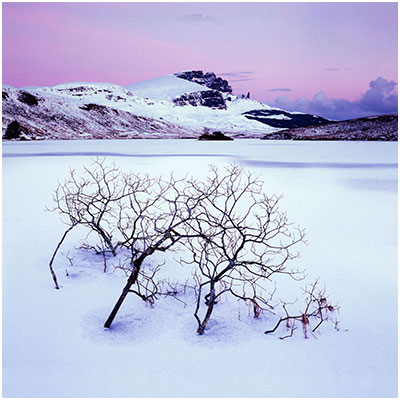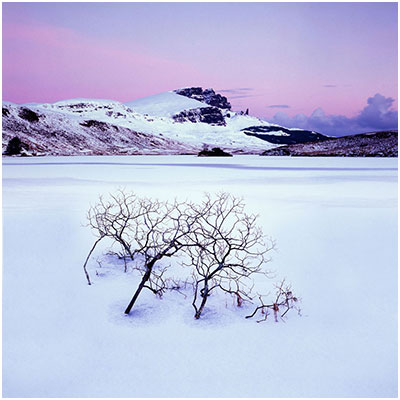I often feel that many of us are attracted to different focal length lenses simply because of the difference in angle of view they provide.
Wide angle lenses allow us to fit more into the frame, but at the same time, they make everything smaller. Conversely, zooming up the focal lengths, allows us to fit less into the frame, and what is included, tends to be more present.
So changing focal lengths affects two things in one go: angle of view, and subject presence. Only, most of us really only think about angle of view.
In this post, I'd like to discuss how using a fixed focal length and zooming with our feet, can radically change the compositional balance between foreground and background subjects.

In the above image, this is how I perceived the location in my mind's eye.
I had decided I loved the background mountains so much that I wanted them to have as much presence in the frame as the foreground bush.
However, as soon as I got close to where the bush was, I ended up with the shot below (note how the background mountain is smaller, and less present in the frame compared to the bush):

What happened was that as soon as I got close to the bush, I realised I needed my trusty wide angle lens (24mm) in order to fit in the bush and also the mountain. I put it on my camera, and all of a sudden everything in the frame got smaller - the mountain and also the bush.
My next step was to walk closer to the bush to give it more presence. This certainly worked - the bush became pretty dominant in the frame, but the background did not change in presence at all. And this is a key point to think about here:
"When you put on a wide angle lens, everything gets smaller, and if you move closer to your foreground, it changes dramatically while your background remains the same."
My foreground became more dominant, while my background became less dominant.
Here is the same location, shot at 24mm again, but in this instance, I moved about 3 feet back:

Notice how the background mountains have not changed in size, but that the foreground bush has become less dominant. The key point to this is:
"By keeping a fixed focal length (in this case 24mm), and moving closer to, or further away from the foreground subject, only the foreground subject changes in size and becomes more dominant, or less dominant respectively"
Ok, so you may be asking - well how did Bruce manage to get the first shot then? And the simple answer is that I used the same focal length as my eye - I used the equivalent of a 50mm lens, to ensure my background mountains were the same size as I had originally perceived them. I then walked back until I could fit in the bush. The key point about this is that:
"When you zoom in, everything gets bigger, but you can only influence your immediate foreground. By moving back 10 feet or so, you can radically change your foreground, while keeping the background the same size."
For this very reason, I prefer to set a fixed focal length, and zoom with my feet. It's also the reason why I prefer fixed focal length lenses to zooms (at least until you fully understand the properties of using different focal lengths).
The key points about doing this are:
- When moving around a landscape with the same focal length, the background does not change size - even if I move 20 feet back, or 30 feet back, the background remains the same. The foreground however, changes dramatically.
- I figure out how big I want my background to be and zoom the lens to fit the background it in the frame.
- I then zoom with my feet. By moving nearer towards / further away from my foreground, I am able to get the right amount of proportion of foreground to balance with the background.
Those of you who have attended workshops with me, will know that I spend a lot of time balancing objects within the frame. I often think of proportions and spacial distances between objects and how they relate to each other. For many of us, this is as natural as computing where to put our hand to catch a ball, while for the rest of us, it's something we have to work at very much.
By zooming with a zoom lens on location, you make composition harder - because you move two goal posts at the same time: angle of view, and presence of objects within the frame.
"I find it is rarely a good idea to stand at one spot and zoom, because although I may fit everything I want into the frame, I'm not giving the background and foreground the correct amount of proportion to each other."
By using a fixed focal length, I have decided how big my background is going to be, and I use my feet to change the foreground presence to balance against my background. In the examples above, I chose to make the background mountain a certain size in the frame, and I then moved back and forth with my feet to increase / decrease the size of the foreground bush in relation to the background.
In other words, I spent a bit of time balancing the dominance of foreground subject with background subject.
If you own a zoom lens, then try to avoid zooming in and out to fit a subject into the frame. Instead, determine what size you want your background to be, and then zoom to fit that. Then keep the focal length static and move with your feet to fit in the foreground.
"Focal lengths are really for controlling background to foreground presence."
